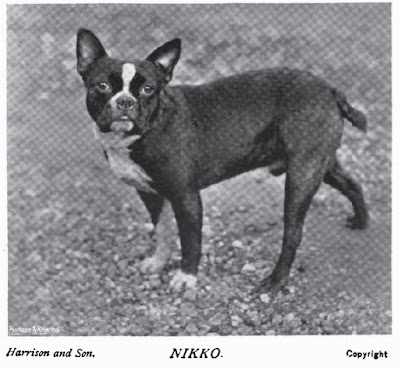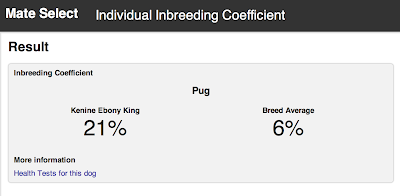The move is intended as a reward to a breed club that has, under the health stewardship of Penny Rankine-Parsons, embraced that there are problems in the breed and the need for research/health surveys.
The problem is that there's no evidence that any of the breed club's initiatives have actually improved the health of the breed.
There is certainly little evidence that Frenchie breeders are willing to give up on a conformation that in the past 100 years has tilted this breed from moderate to extreme brachycephalism... the same health-compromising, dim-witted direction that affects so many of the brachycephalic breeds.
The Frenchie breed standard in fact calls for a "well-defined" muzzle, but in profile the breed now has practically no muzzle - a far cry from some of the dogs of old.
 |
| Left: BOB French Bulldog 2011. Right:French Bulldog 1917 |
As the English Club's own advice on health spells out: "Being a brachycephalic breed that is fairly short and compact with a screw tail, the 'Frenchie' is prone to the associated problems these conformational characteristics will bring."
Of course. It's immutable. Set in stone.
Have a look at the dogs being exhibited by current top winning kennel, Glenlee - including the Crufts 2013 winner, Renuar New War Bonnet. You can see their current showteam here; it boasts a veritable smorgasbord of stenotic nares.
The 2004 KC/BSAVA survey found that 53% of French Bulldogs suffer one or more health conditions and that the median age of death is 9 years old (only two thirds of the "lifespan of around 12-14 years on average" claimed by the French Bulldog Club of England).
Additionally, many can't mate naturally, over 80 per cent of the breed is delivered by C-section (ref here) and there is a neonatal puppy mortality rate of around 30 per cent.
Yep, this breed doesn't want to mate, doesn't want to be born and does its level best to die if forced into it.
Have a look at this American breeder's site for some eye-watering honesty about French Bulldogs.
It also states, as if it's bad thing: "Bargain-priced French Bulldog pups are bred for from large, long-backed, small-headed, out-at-the-nose French Bulldogs who can breed naturally because of their longer backs and legs. Puppy mills prefer them like this because the small-headed pups they produce can free-whelp without need of a costly cesarian making them more profit."
And just so we can tell the difference, there's a helpful illustration comparing the dreadful small-head, longer-nosed, free-mating, free-whelping ones and the desirable huge-headed, flat-faced, artificially-inseminated, c-sectioned ones.
 |
| Apparently, you're supposed to want the one on the right. |
Despite all this dysfunction, only one winning Frenchie in the UK has failed a vet check since the KC introduced them in 2012. But don't be surprised - the vet checks are pretty much rubbish, sufficient to pick up lameness or an obvious eye or skin problem, but useless at picking up anything more fundamental, including exercise intolerance due to underlying brachycephalic obstructed airway syndrome. The vets are not allowed to put a stethoscope on the dogs and the dogs only have to trot up and down a few yards. Winning dogs are also often carried/wheeled from the ring to the vet-check to give them the best chance of a pass.
So, if the vet checks are mostly a PR exercise, does it matter that the breed is now exempt?
Yes it does because removing Frenchies from the high profile breed list sends out a strong message that the breed is OK when it isn't - and at a time when KC registrations of this breed are soaring. And it also sends out a dangerous message to others on the high profile breed list - i.e. looking like you're doing something to tackle health problems is good enough.
Even more infuriating is that this morning the Dog Advisory Council - the independent body set up to monitor and find ways to improve dog health post Pedigree Dogs Exposed - has congratulated the breed club for being relieved of what it calls the "stigma" of being on the high profile breed list, as if somehow the Frenchie didn't deserve such a label.
This makes no sense at all. The Dog Advisory Council has stated clearly that it thinks the vet checks are "flimsy" and should be replaced with something much more robust. Why then should removal from such a meaningless test warrant any congratulations? And why would it see being a high profile breed a "stigma" rather than, say, an opportunity?
The answer? I suspect it's that the Council's David Sargan is working closely with the breed club's health rep, Penny Rankine-Parsons, on a Cambridge Vet School initiative to find a way to measure respiratory function in brachycepahlic breeds. (For more info see here.) It is a commendable project - and the French Bulldog breed club has been much better than the Pug Club in offering support.
All good stuff.
But this doesn't take away the fact that the French Bulldog is a fundamentally unhealthy breed.
I've had an exchange of views about this today on the DACs Facebook page. David Sargan has admonished me for being ungracious in not recognising all the wonderful work the breed club is doing. He also suggests that the most extreme health problems may reside in the swathe of imported puppies from Eastern Europe - something that could be true but for which there is no supporting data.
I have accused Sargan of drinking the breed club Kool-Aid; his perspective shot by the close contact with a handful of people in the breed who are making the right noises (something I've seen so many times). That's not to say that I am dismissive of the measures the breed club is taking to improve breed health. I'm not. It's just that there is no evidence that any of them have been effective as yet (after all, how could they, when most of them are so new?)
And, anyway, the measures don't go far enough.
Frenchie breeders need to give this breed back some muzzle. The club also needs to state emphatically that dogs that have had surgery to correct breathing problems should never be bred from - instead of its current advice that they can be used as long as mated to a more sound dog.
Stenotic nares need to be severely penalised.
The breed standard should also (as does the FCI standard) call for taillessness, or too short a tail, to be a disqualifying fault and an effort made to breed for a longer back. All Frenchies used to have a tail. But in the pursuit of a shorter body/spine, it has been largely lost, leading to several health problems (see here).
 |
| 1899 French Bulldog - described as being "first-rate in skull and body properties" (Picture courtesy:Pietoro's Dog Breed Historical Pictures) |
 |
| 2013 - top-winning Eastonite Hurricane |
After all, if you were a dog, which would you prefer to be... This one, from 1925?
Or this one?
 |
| Crufts 2011 |




